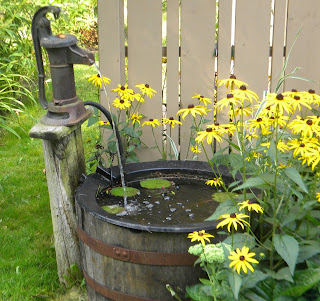Autumn Crocus
 |
| Autumn Crocuses |
Autumn Crocus or Colchicum
 |
| This is what the Autumn Crocuses look like in the spring. The flower doesn't appear until early fall. |
These fall beauties pop up in a matter of days in early fall. No foliage- just the flowers on stems. The foliage appears in the spring and then dies back in early summer (see photo at right). The Autumn Crocus is not a true crocus, but species or hybrids of Colchicum, a group of fall flowering bulbs in the lily family. They do best planted in full sun. You can plant them in low growing ground covers or perennial beds. If you want to move or divide them do it in summer after the leaves have died back, but before the flowers come up.
Japanese Iris (Iris Ensata)
| Japanese Iris 2013 |
| Japanese Iris 2013 |
It is important to dig up and divide your plants about every 3-4 years to keep them vigorous and also because the new roots form above the old roots forcing the crown of the plant out of the ground. When dividing, cut back 1/3 of the foilage, dig up the crown, divide into fans and cut off the old roots. To prepare them for winter, after a frost cut down the foilage to the ground.
Impatiens And Downy Mildew
 |
| Impatiens 2009 |
The disease can spread from flowers to other areas of your yard by the wind carrying the spores, and the spores can also survive in the ground over winter. If you had infected impatiens this year, you should not plant them next year because the spores could still be in your soil. At this point in time they are not sure how long the spores can survive (1-5 years?). Downy mildew survives in humid or moist conditions, as well as crowded plants. If you have them in your garden now, and they have the downy mildew, when you remove them do not add them to your compost pile. Discard them in the trash. One of my neighbors had downy mildew on her impatiens last year, and replaced them with new plants from a nursery and the same thing happened to the new impatiens. After discarding the plants and soil and replacing it with new soil she planted them again this year and they were fine.
The New Guinea impatiens are not affected by this downy mildew. I think that might be one of the reasons there were so many New Guinea impatiens planted on the grounds of Boldt Castle that I shared with you in the previous issue of my Garden Blog.
Here is a link with pictures of Impatiens with Downy Mildew: Impatiens and Downy Mildew
2013 Garden Highlights
 |
| Oriental Lily - "Tiger Woods" |
Sundrops are one of my favorite perennials. They are not invasive, but they do spread out, and are easy to remove if your clumps are getting too crowded. I like adding these around the different areas of our yard because they bring a "pop" of color to selected areas in early summer.
| Lady's Mantle (Alchemilla Mollis) |
I love how the rain beads up on the Lady's Mantle. They can get a little washed out and pale looking around the middle of the season and if that occurs you can cut them back and they will come back the same season. Lady's Mantle (Alchemilla) has chartreuse flowers and does well in partial shade.
| Astilbe |
 |
| Ligularia "The Rocket" |
The first year our Japanese Stewartia tree bloomed.
 |
| Attractive bark on Japanese Stewartia Tree |
Preparing for Winter - What You Need To Do
Favorite Tools
| D-handled pointed shovel (30") and kneeler |
Fall Chores in the Garden
Continue to weed your gardens. Fall is a good time to weed because with all the rain the ground is not as hard and the weeds usually pull out easier. And you will keep weed seeds from sprouting next spring. If you are having a dry fall you will need to continue watering your newly planted perennials, shrubs, and trees so their roots can get established before winter. When you water you need to water deep, not just a spray or sprinkling. With a deep watering your plants are sending the roots down deep. With a light watering the roots will stay near the surface where the water is and will not send their roots down deep.
You will need to rake up leaves if you have a lot in your yard. You will want to get them off your lawn because if they are thick and stay on over winter they can suffocate your lawn. Use the raked leaves as mulch in the garden or add to your compost pile. And the same with pine needles. You can rake them up and put them around your azaleas, rhododendron, and your strawberry plants. You will also need to pull out your dead annuals. Sometimes I even pull them out before a frost if they are not blooming very well. If you mulch your perennials be sure not to cover the crown or center of the plant because if water builds up in there it can cause rot. If you have any house plants outside, now would be a good time to re-pot them if they need it. Check them over for any bugs as well. And of course- get your snow shovel ready!
| Japanese Anemone |


































